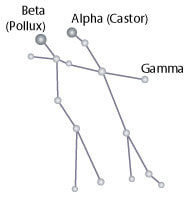 This piece was originally broadcast on Radio Scilly in March 2019. I do love this time of year when the nights start drawing back and you’re no longer walking to and from work in the dark. However the downside does mean later nights for us stargazers, and, potentially, the start of bleary-eyed mornings. That aside, the Spring constellations are slowly working their way into peak position in the night sky. Gemini and Leo are taking prominence high in the sky at the moment, with the very faint Cancer in between – if these names sound familiar it’s probably because you’ve read about them in the back of a magazine in your horoscope…and yes, they are constellations of the Zodiac. But I’m not talking about astrology or your ‘star signs’ here. Astrology – unlike astronomy – is not a science, although to be fair, they both involve the stars. That’s where it ends. Astronomy can explain the position of the stars in the sky, but frankly, it’s up to you and Mystic Meg to interpret their meaning. In astronomy, the Zodiac refers to the twelve constellations that our Sun passes through, identified back in the day by the ancient Babylonians. This area of sky also includes the apparent paths of the moon and the planets. We also call this imaginary line frequented by Moon, Sun and planets ‘the ecliptic’. Back to what you can actually see. Gemini is easy to spot, even for the most amateur of stargazers. It’s at its best right about now. You’ll spot Gemini northeast of Orion and it looks (if you join the imaginary dots) like two stick men holding hands. Apt, because Gemini represents the twins. Making it one of the few constellations that actually looks vaguely like what it’s called! The twins in question are Castor and Pollux from Greek mythology, inseparable brothers who became known as the Sons of Zeus. They were placed in the sky by dear old Zeus to honour their brotherly love. And there you are: Castor and Pollux are the names of the two brightest stars, which form the heads of our starry stick-twins. Back on Earth, we’re gearing up for the start of the season on St Martins, and our observatory will be open to the public from the beginning of April. For 2019 our regular openings –come rain or shine- will be Tuesday evenings and Friday afternoons, for a look around and fingers crossed some star (or sun) gazing. We will be open other nights, but those will vary week to week depending on the weather and interesting night sky events. If you’d like to visit or find out more, drop me an email, have a look at our website, or find our group on Facebook. Email: [email protected] Facebook: COSMOS Community Observatory St Martins on Scilly
0 Comments
Your comment will be posted after it is approved.
Leave a Reply. |
BYCharlie Payne POSTS
September 2024
|

 RSS Feed
RSS Feed